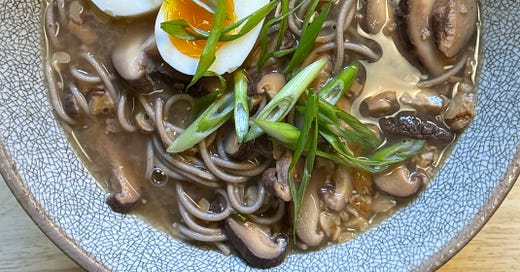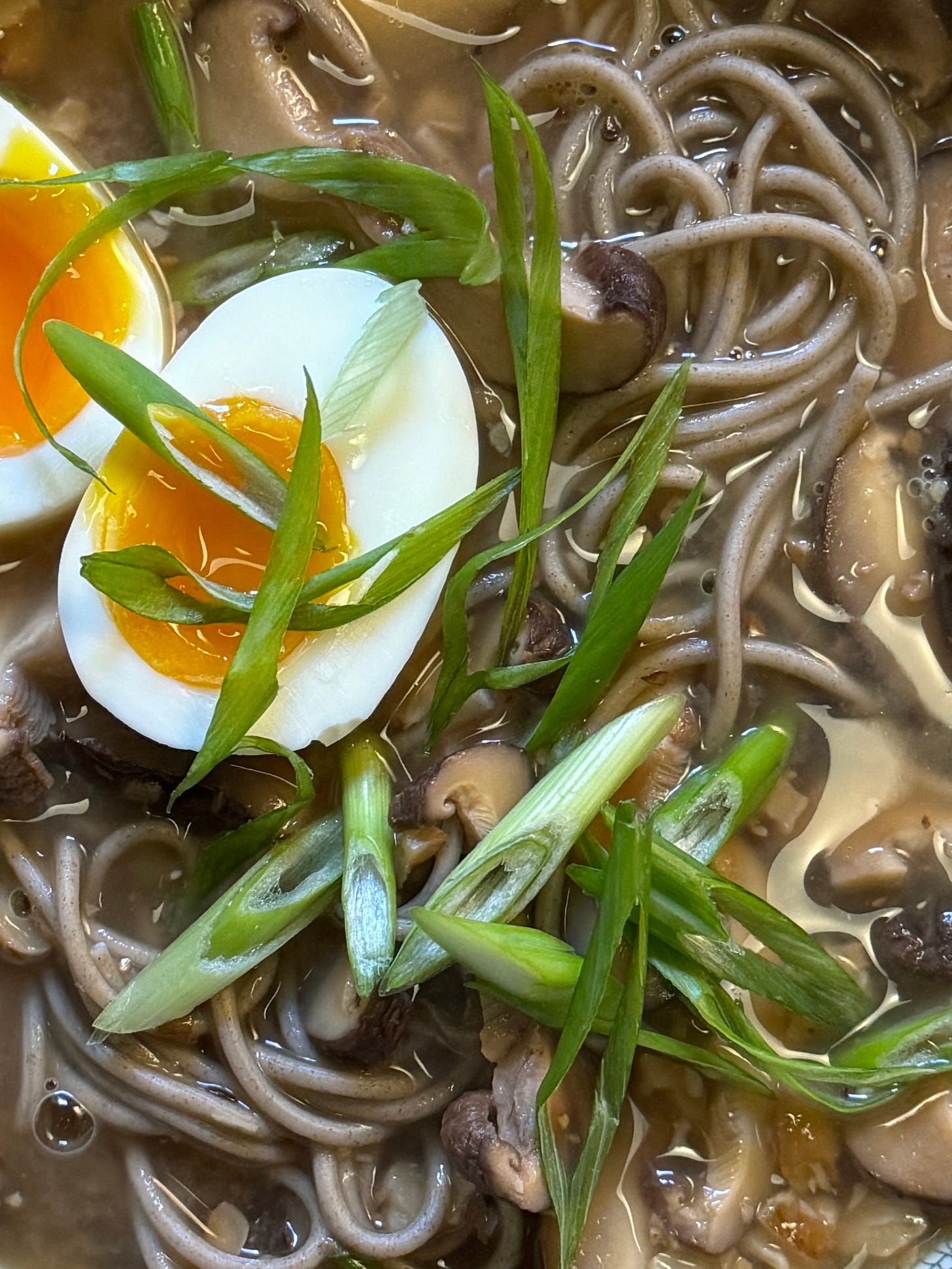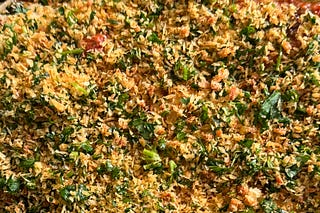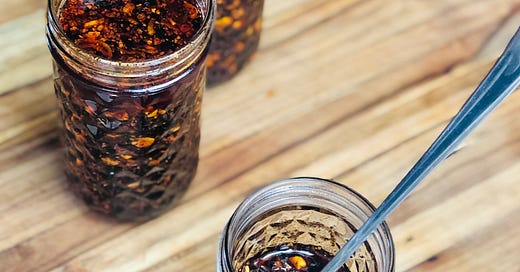

Discover more from Hot Dish with Sohla
I’ve always been a big fan of instant dashi, which is to dashi (the delicate Japanese stock made from kombu and katsuobushi) what chicken bouillon is to chicken broth. The concentrated crystals instantly dissolve to smack savory wherever you add them. I can’t think of a better pinch hitter when strapped for time (or have a baby strapped me). And it excels as a dry seasoning for snacks like popcorn or chex mix. But I’ve got to admit that my love for instant dashi wasn’t always for the right reasons. I was afraid of making dashi from scratch.
I was first introduced to dashi while working in fine-dining restaurants, where angry chefs would shout very specific instructions at me out from under their stiff paper hats. Add 276 grams kombu to 10121 grams of water. Hold at 72C for 82 1/2 minutes. Add 312.51 grams of kastubushi shaved 1 mm thick no more than 32 seconds prior to using. DO NOT STIR. So yeah, I was traumatized.
I was taught how to make dashi so terrifyingly rigidly because the chefs themselves didn’t understand it. I finally overcame my fears when I got to hang out with Chef Yuji Haraguchi while shooting a series with Masterclass last summer (it’s all about breakfast if you need some morning meal inspiration). He very matter-of-factly stated, “Dashi just means stock. You can make it lots of ways.”
You have no idea how his words freed me from years of terror. All this time, I thought I’d be insulting hundreds of years of Japanese culinary tradition if I added even one extra flake of bonito, but apparently, it’s not that serious. However, like chicken broth, there are levels. A store-bought carton of chicken broth is an entirely different product from a homemade broth made of long-simmered, roasted bones. Kasuobushi and kombu come in varying levels of quality. You can add additional ingredients. You can play with ratios of water to kombu. You can simmer then cold steep, cold steep then simmer, vacuum seal and circulate, but you can read more about that here. I won’t get into all that because I want you to be unafraid of dashi.
Here’s what you need to know:
It starts with kombu (dried giant kelp), which is rich in glutamic acid (UMAMI, BABY!). Never boil it, which can make your dashi bitter. Most recipes add kombu to water, bring it to a bare simmer, and then remove it. Feel free to play around here, cold steeping the kombu in water, steeping after boiling, boiling after cold steeping, it’s an adventure every time. (Save the steeped kombu to thinly slice and add to salads.)
Next, add bonito flakes, which contain inosinic acid, another source of umami that, when combined with the glutamic acid in kombu, becomes SUPER UMAMI. Again, never boil it, which can make the dashi fishy. Play around with how long you steep it. Some recipes simmer the flakes gently, while others recommend only the briefest steep. You do you, boo. (Save the steeped bonito to mix with soy and use as a rice or tofu topping.)
Bonus points: Amp up the umami by adding dried sardines, dried anchovies, and/or dried shiitake mushrooms, all containing other fun-sounding acids that work together with glutamic acid to create MEGA UMAMI. Just think of kombu, katsuobushi, and the other ingredients as the Planeteers. When their powers combine, you get Captain Planet, ahem, I mean, dashi.
Most importantly, don’t forget to have fun while you go off and explore dashi in your kitchen. You’re alone, and there are no torqued thugs around to throw hot pans at you. But still keep that instant stuff around for some savory oatmeal.
In non-dashi news:
The book tour is over! And even though I missed the babe back home, seeing so many of you in person was truly fulfilling. Thank you so much to everyone who waited in long lines, sat in cramped and often hot rooms, and laughed at all my bad jokes. As someone who threw parties as a kid that no one showed up for, seeing full rooms filled my heart, as cheesy as that sounds. If you missed me, you can still get a digital ticket and stream the Seattle convo until 7:30 pm tonight.
There’s a new episode of Cooking 101 on NYT Cooking’s YouTube channel and it’s all about rice.
Ham and I have a new podcast miniseries called DEEP DISH in partnership with our friends at the Sporkful. We nerd out about food, then go home and cook. Listen to it in the Sporkful feed wherever you listen to podcasts.
Yo Queiro Taco Seasoning is back in stock!
Mushroom Miso Noodle Soup
serves 4 | active time: 45 minutes | total time: at least 2 hours 45 minutes
The base for this soup is a mushroom dashi that combines kombu, katsuobushi, and shiitake mushrooms for a deeply colored and flavored broth. My (current) preferred method to make dashi begins by cold steeping kombu (and, in this case, mushrooms) overnight. Then, bring that to a bare simmer and remove from heat. Add the bonito and let sit until it sinks to the bottom of the pot.
I give you a range for the quantity of noodles to use, because how much nood you want is too personal for me to tell you what to do.
Got extra soba? Make my Brothy Clams with Soba
Got extra miso? Make my Salty-Sweet Party Mix
INGREDIENTS
For the dashi:
10 cups water
1 6-inch piece kombu (1 ounce)
16 dried shiitake mushrooms (about 3 ounces)
1 packed cup dried bonito flakes (½ ounce)
For the soup:
4 large eggs (optional)
8 to 12 ounces dried soba noodles
4 tablespoons butter
⅔ cup raw walnuts, chopped
6 scallions, thinly sliced, white and green parts separated
4 garlic cloves, thinly sliced
1 tablespoon soy sauce
1 tablespoon maple syrup
1 teaspoon freshly ground black pepper
¼ cup white miso paste
Make the dashi: Combine the water, kombu, and mushrooms—cover and steep at least 2 hours at room temperature or (preferably) overnight in the fridge. Bring to a bare simmer, then remove from heat. Add bonito flakes and let steep until they sink to the bottom of the pot, about 20 minutes.
Strain through a fine mesh strainer. Reserve the kombu and bonito for another use (or another round of dashi). Trim and discard the stems from the mushrooms, then thinly slice. You should have about 2 quarts of dashi.
Cook the eggs (if using): Bring a small pot of water to a boil. Use a slotted spoon to carefully lower the eggs into the water and set a timer for 7 minutes. Remove from heat, drain the water from the pan, use the back of a spoon to gently crack the eggs all over, then add cool tap water to chill the eggs slightly. Peel, halve, and set aside.
Meanwhile, cook the soba: Bring a medium pot of water to a boil. Cook the soba noodles until tender, then drain through a colander. Rinse with running water, raking your fingers through the noodles to ensure it fully cools. Set aside to continue draining while you make the soup.
Make the soup: In the same medium pot (now drained of water) add the butter, walnuts, scallion whites, and garlic. Cook over medium heat, stirring frequently, until the butter has browned and the nuts and garlic are barely golden and aromatic, 3 to 5 minutes.
Add the sliced mushrooms and stir to cool the pan, halting the browning of the butter. Add the soy, maple, and pepper and cook until the pepper is fragrant and the soy and maple are absorbed by the mushrooms, about 1 minute.
Add the mushroom dashi, increase the heat to medium-high, and bring to a simmer. In a small bowl, stir with miso with some of the hot dashi to dissolve, then add to the soup. Remove from heat.
Divide the noodles between the bowls, then top with the soup. Garnish with scallion greens, egg (if using), and serve right away.
Subscribe to Hot Dish with Sohla
New exclusive recipes every month! Featuring fun tips on how to riff and deep dives into culinary techniques—so you can be a boss in your kitchen.


















Thanks for linking the Hondashi! Love that I have an excuse to grab mushrooms at the farmers market this week.